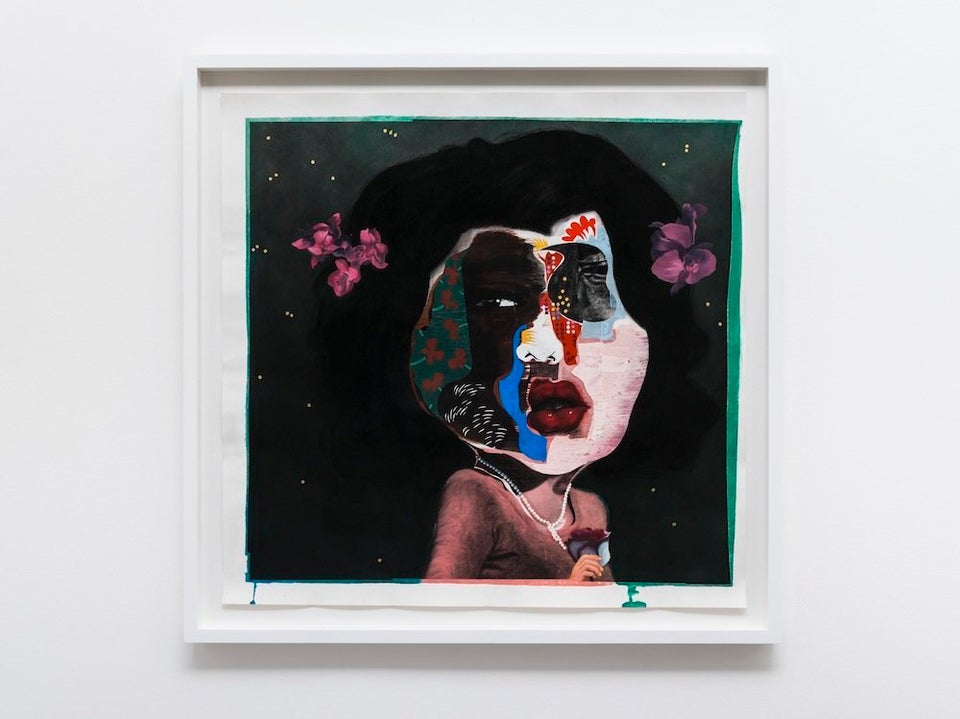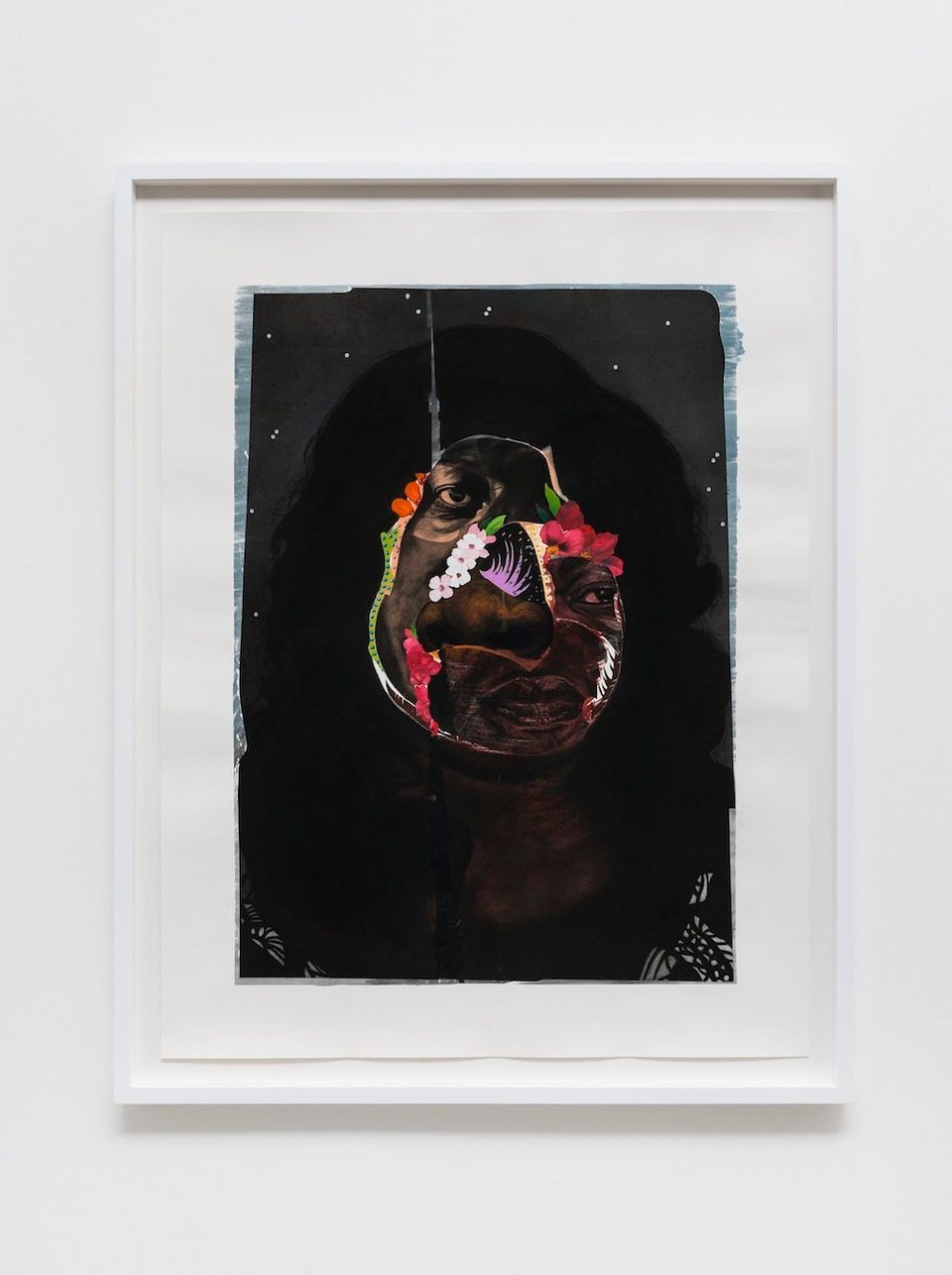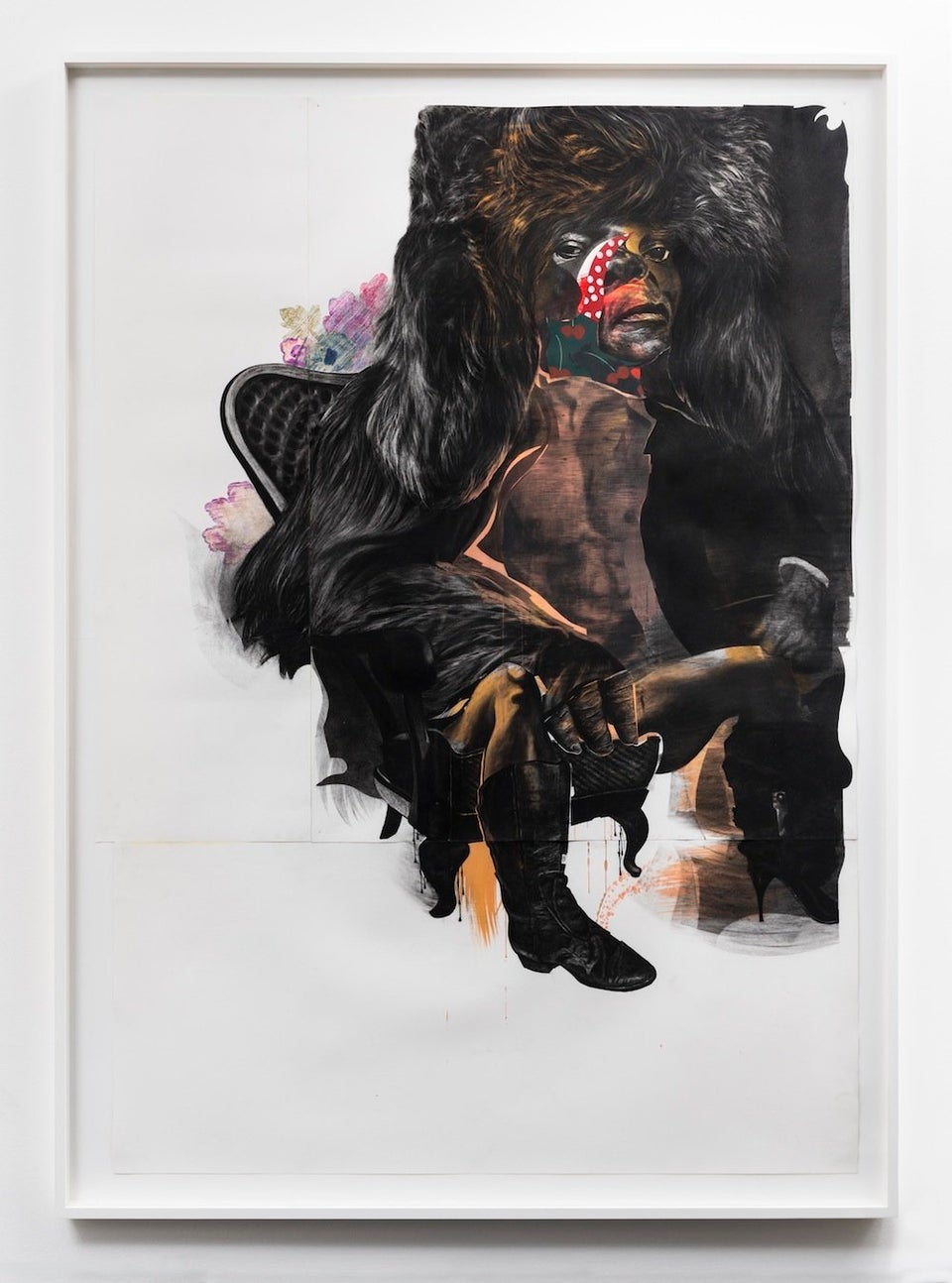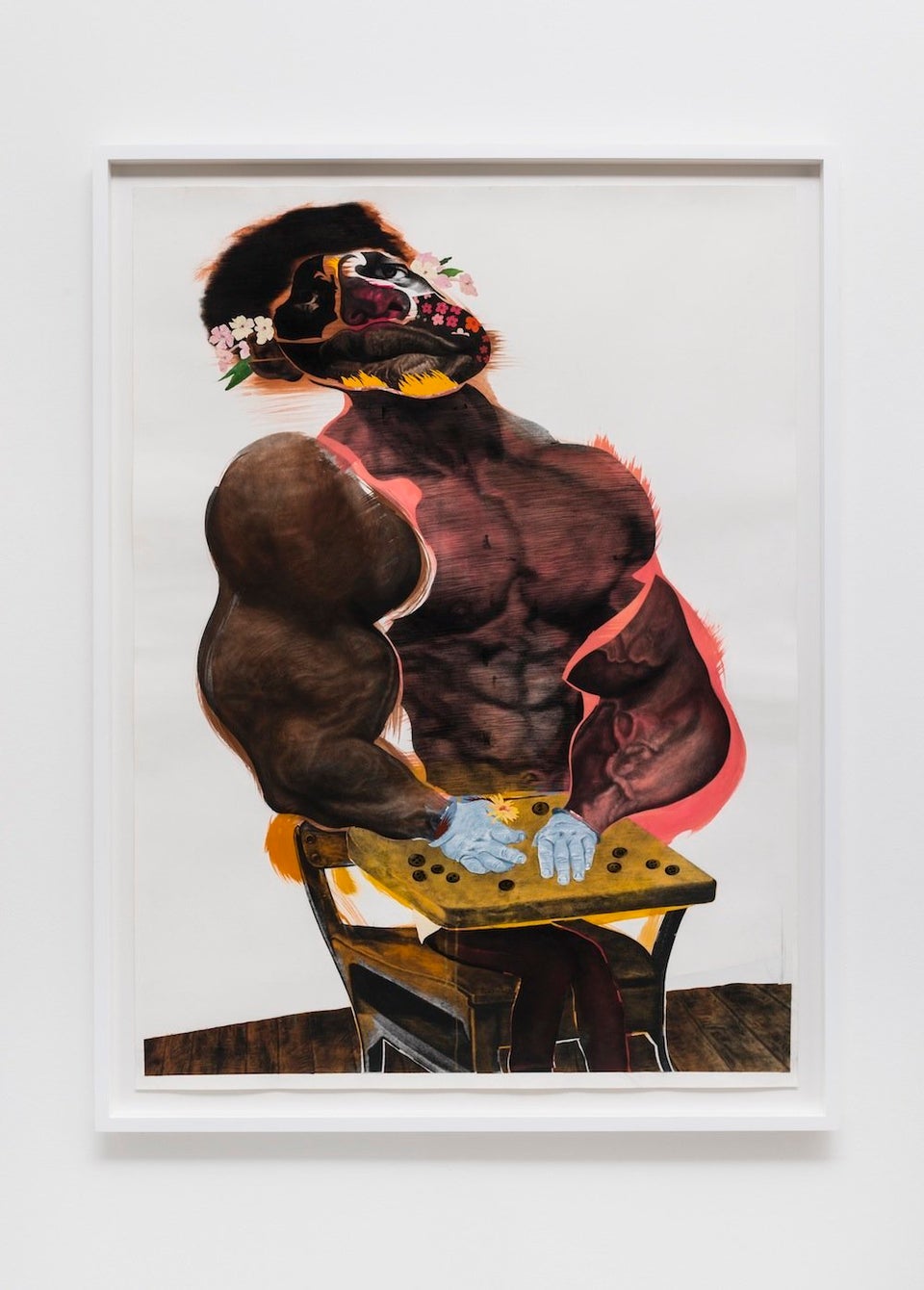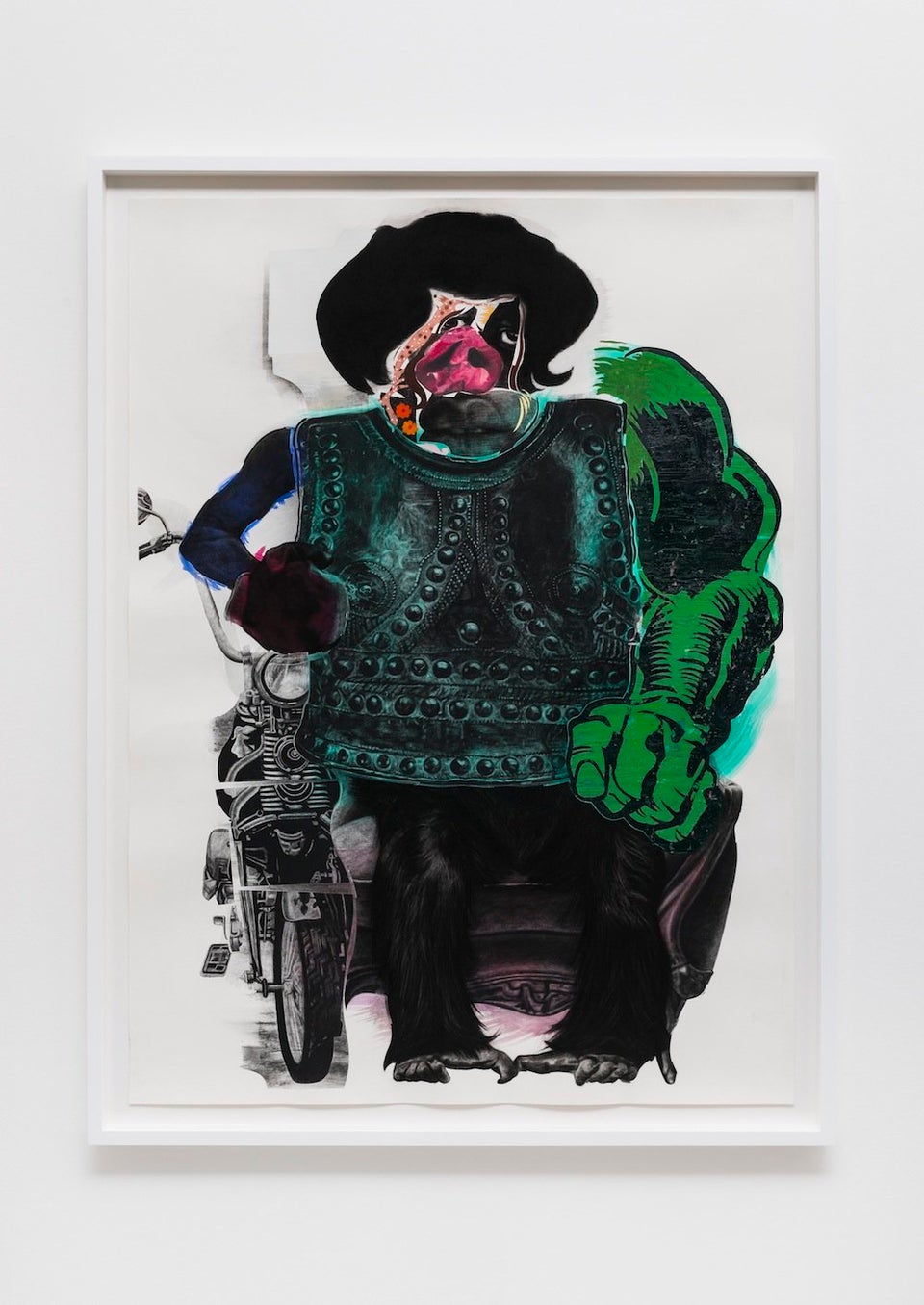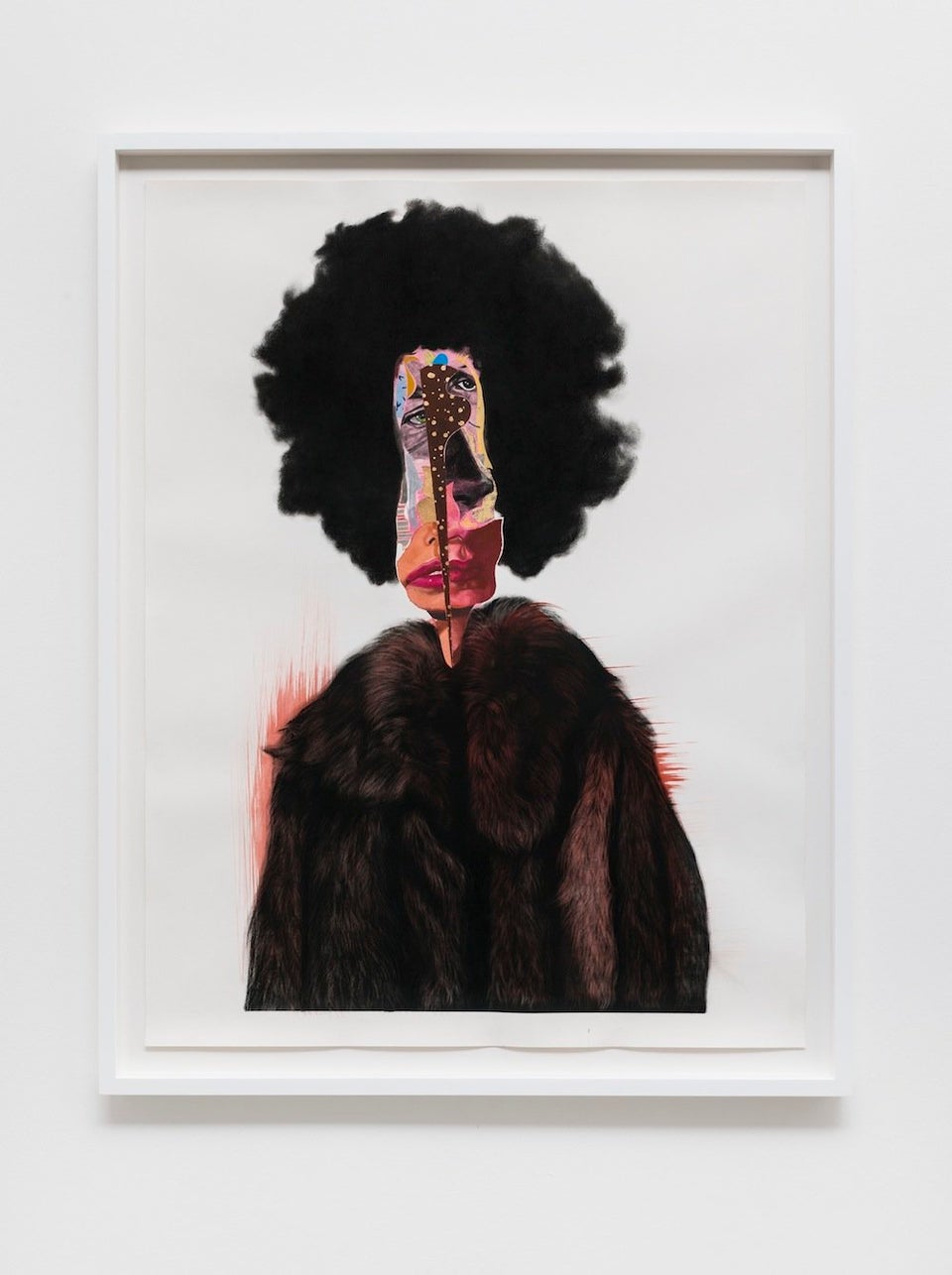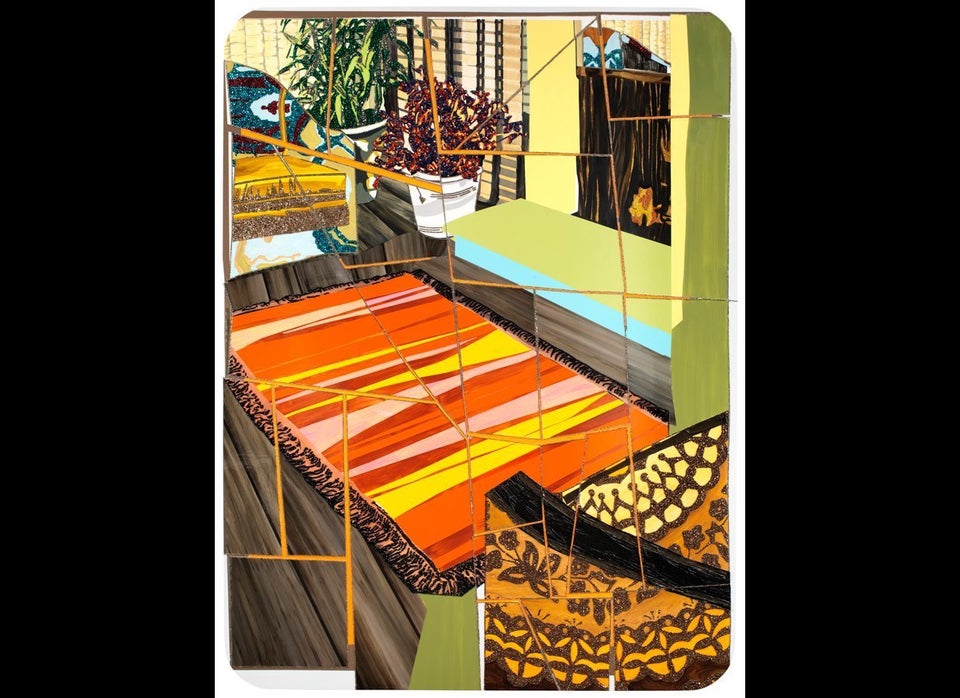Gazing upon a series of Nathaniel Mary Quinn's paintings feels like staring into a Ripley's-esque hall of medical oddities and botched surgeries, situated alongside the black sheep and circus performers themselves who'd banded into a cast of outcasts. And yet the multimedia hybrids feel above all truthful. The portraits -- bulging, distorted and ripped to shreds -- capture something real about our bruised senses of self. Something we often look away from.
Quinn's series "Past/Present" features large scale works combining black charcoal, oil-paint, paint-stick, gouache, oil pastel and cardboard. Somewhere between Wangechi Mutu and Francis Bacon, the works are as intoxicating as they are repulsive, like a stranger you're eager to know though already frightened by. Quinn's images possess a perpetual sense of now-ness, as if capturing a person at a particular moment, tangled up in all the moods, memories and whatever else happens to be lingering in the air.
We reached out to the artist to learn more about this hypnotic series.
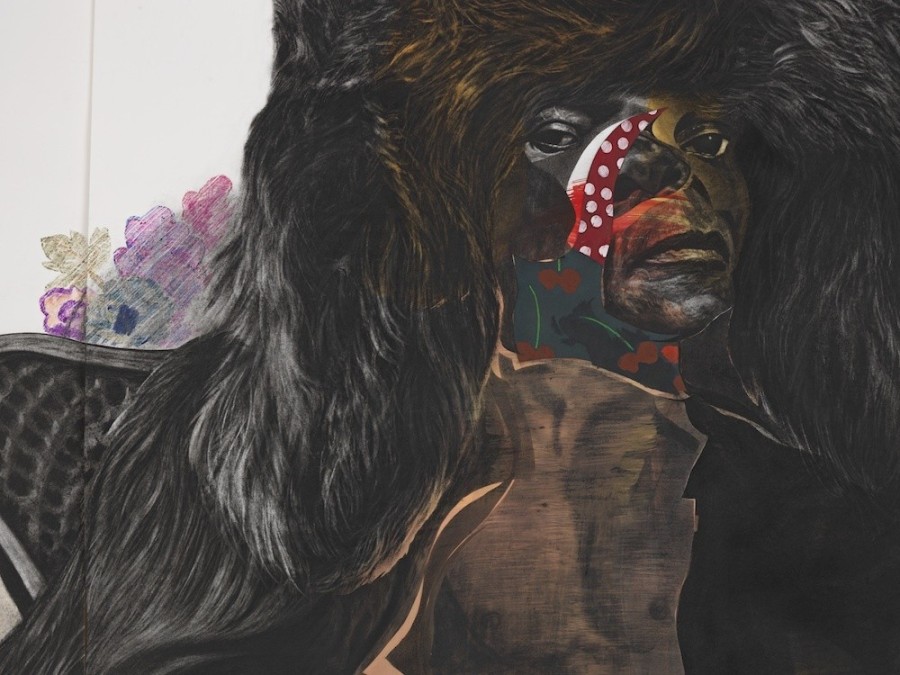
(Detail) King Kong Ain't Got Nothing On Me, 2013, black charcoal, gouache, oil pastel on Coventry vellum paper
When did you first start creating art and how did it affect other aspects of your life?
As a child, my mother allowed me to draw on the walls of our apartment. She would just clean the walls and let me draw again, repeatedly. My work seems to investigate my childhood upbringing, my past experiences, and my humanity.
Since 2002, soon after earning my MFA from New York University, I embarked on an artistic pursuit of creating work predicated on black identity, racial and gender politics, or a critique of mainstream culture. I presumed that such was the correct path for me. Two years ago, I disengaged from that path. My conviction for such issues lacked the potency necessary for sustaining my studio art practice. Moreover, I had come to accept that I was unhappy with my art practice. There was something more that I wanted to explore, although I had no scathing idea as to what such a conviction looked or felt like. Then, I began making work based on my visions, absent of any knowledge as to what these visions meant. I simply had a visceral response to these visions. For the first time in more than ten years, I was consumed by a confident sense of happiness and completeness. I felt like a child in a magnificent playground.
By this time, I had stopped making preliminary sketches. The visions were so explicitly clear, that making pre-sketches was unnecessary. After completing my first body of work, it had dawned on me that instead of composing a theory upon which my work would be based, my work would reveal to me what I, on some known or unknown level, continue to endure. My work would function as a sound reflection of my identity and human experience. My work reveals unresolved issues as related to my family, my childhood experiences, and the link between such experiences and my current disposition. My work allows me to explore the power of being present, while bringing to surface buried memories culled from my childhood experiences and upbringing in Chicago. In this journey, I acknowledge the pain and sorrow that I continue to endure, the sense of progress that I enjoy, and the sense of deliverance upon which I stand.
My work is also influenced by my upbringing in the Robert Taylor Homes of Chicago, which were, for many years, one of the most infamous and dangerous tenement housing complexes in the nation. I was the youngest of five boys. By the time I was fifteen years old, my other brothers were already young adults, along with being high school dropouts, drug addicts, and alcoholics. My parents were illiterate. My mother, Mary Quinn, was crippled due to having two strokes. My father, Joe, frequented pool halls for the sake of gambling in order to feed our family.
By my eighth grade year, I won an academic scholarship to attend Culver Academies, a private boarding high school in Indiana. Soon after the start of the school year, my mother passed away. The following month, upon arriving home for Thanksgiving break, I found an empty apartment. My family was gone, and I have not seen them since.
I wondered why I had such an obsession with creating jagged, fragmented, discontinuous portraits and figures. Now, I am beginning to understand: the dilemma of unresolved abandonment, separation, and attachment issues prevalent in my identity and sub-consciousness. Yet, there is something redemptive within this context, of separate, seemingly unrelated, parts mending themselves together, managing, somehow, to achieve a sense of cohesion and solidarity. Such was compounded with relationships I found between my work and Cubism, as well as the works of artists like Francis Bacon and Neo Rauch. The works of Francis Bacon are especially powerful for me, where his expressive and graphic approach creates a relationship between the grotesque and the beautiful.
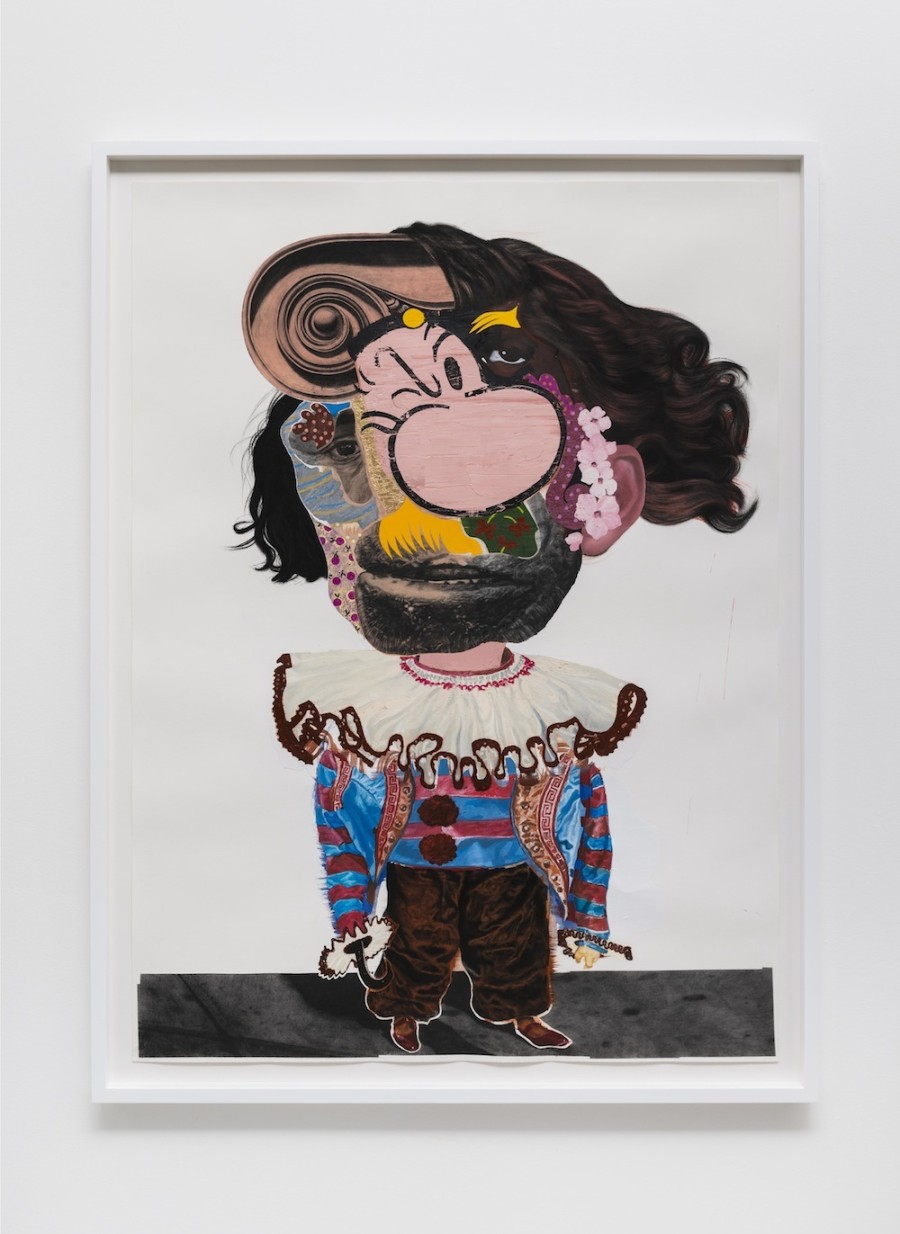
Clown, 2014, black charcoal, oil-pastel, oil-paint, paint-stick, gouache on Lenox Paper
What information goes into these portraits and how do you translate this information into image?
My portraits and figures tend to be based on people that I knew during my childhood. In some cases, they represent people that I currently know. However, it is a bit more complicated than that. People do not exist without that which creates them, without that which influences their behavior, their belief-systems, their conditioned thought patterns. I am more interested in what is underneath. I want to convey all that is hidden.
And, of course, all of my portraits and figures are extensions of my identity. Perhaps I would not be who I am without these people. The real dilemma rests in understanding the link between my experiences with these people and my current disposition as a human being. Hence, my studio practice is inundated with exacting my focus on being as free as possible from all conditioned thought patterns and belief-systems. This requires the removal of excessive thinking, for it is our “thought-mind” that happens to be poisoned with illusions that are not true, but appears to be true due to the amount of emotional energy that we invest in such illusions. For example, in my work, I explore the reasoning behind what may appear to be feelings of worthlessness. By all means, I was, in fact, abandoned by my family when I was fifteen years old. Therefore, logically speaking, as a fifteen year old, the bridge is not that wide between being deserted by the only people who proclaimed and demonstrated their unwavering love for you and the notion of not being worthy of authentic love and compassion: “If your own family doesn’t want you, then who will?” But, is this true?
As an adult, I now realize the existence of other explanations behind their sudden and abrupt departure: severe lack of money, poverty, being evicted, forthcoming violence. However, it is nearly impossible to understand this as a child. Before you know it, and against your will, your mind develops a belief-system that impedes upon your ability to function happily. For years, I ruined all of my significant relationships and friendships on the promise of this belief system: “How can I be sure that you won’t abandoned me if my own family deserted me?” And I feel this everyday and put it into my work, to create what I feel, within the context of being present, of embracing my state of being, in order to get underneath it all, to explore it, to uncover, as much as possible, the inner-workings of my identity. This is a highly grotesque process; yet, it is very beautiful because of the power of self-acceptance, even against a collective perception that works relentlessly to convince you to believe in the benefits of hiding your scars and bruises.
Your works also toy with gender in interesting ways. Can you explain what argument you're making in this respect, if any?
I am not making an argument in my work as it relates to gender. I employ any visual reference necessary for the creation of my work. I presume gender comes into play as a result of my mother. In some way, I am always painting and drawing my mother, especially being that I lost her when I was fifteen years old. Many people can relate to this. That sort of pain never leaves you. You can only turn down the volume of the pain, but the sound never goes off. I continue to yearn for her, so perhaps she is coming through my work, somehow, presenting herself in various ways.
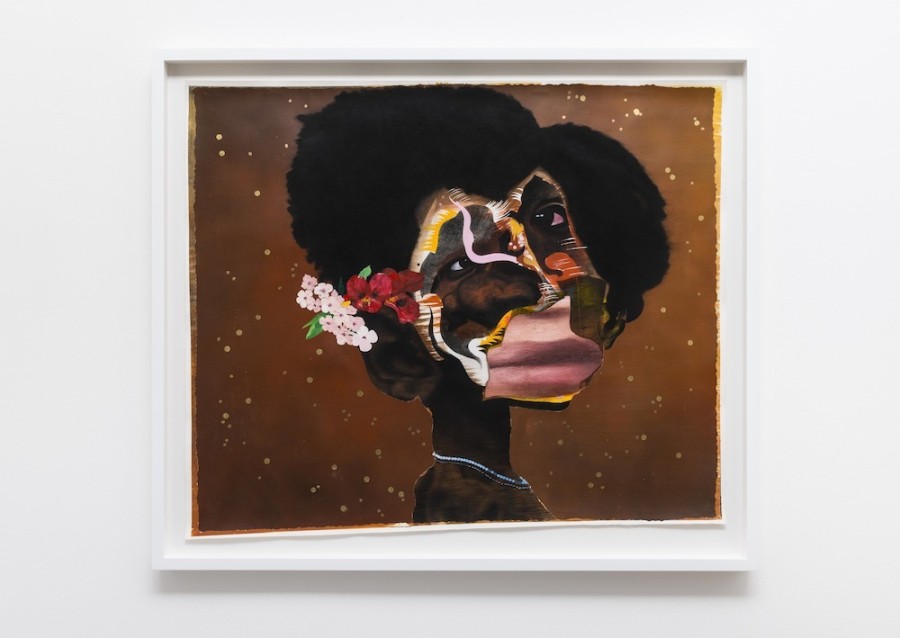
Monique, 2014 black charcoal, oil-pastel, oil-paint, paint-stick, gouache on Lenox Paper
This show reminded me of Mickalene Thomas' recent exhibition “Tete de Femme,”which similarly explored the fractured geometry of the face. What similarities and differences do you think apply?
Mickalene Thomas’ work carries a significant amount of weight. Her paintings seem to explore the historical means by which beauty is articulated on canvas. Her collage-like paintings place black women within a narrative from which black women were traditionally excluded. Her 2012 exhibition at the Brooklyn Museum, “The Origin of the Universe,” highlighted the prowess in Mickalene’s artistic career; in some cases, porcelain skin and blonde curls – as evident in the works of Gustav Courbet, for example, were replaced with beautiful black women, bringing to surface the malleable and expressive nature of femininity. It is wonderful that such beauty is being delivered through the subject of black women, and Mickalene is masterful at this.
This past June, her recent exhibition, “Tete de Femme,” at Lehmann Maupin Gallery, presents a relatively fresh and courageous direction for Mickalene –- not a departure; instead, a development from her previous work –- and such may have been developed in her studio practice, particularly as this growth seems to be related to her work with models, make-up, various photo sessions, and experimentation with collages. The persistence in Mickalene’s acute interest in creating correlations between art history and the present moment remains to be relevant.
Although, visually speaking, there are similarities between my work and that of Mickalene Thomas’ in “Tete de Femme,” there are, indeed, differences worth noting.
“Tete de Femme” appears to be the first public exhibition of such a development in Mickalene’s work, and while various correlations can be made between her work and mine, the exploration in my work stems from a different place, and the development with my particular body of work began three years ago -– before “Tete de Femme” publicly existed. Clearly, my work carries influences from Cubism; however, my aim is to explore my humanity and to become more aware of the link between various past experiences and my current disposition. In this effect, there exists no primary interest in positioning black men or women within an exclusive narrative. My work is not governed by the exploration of Cubism and contemporary subject matter. My work is governed by the exploration of my present human existence and the personal history by which it has been informed.
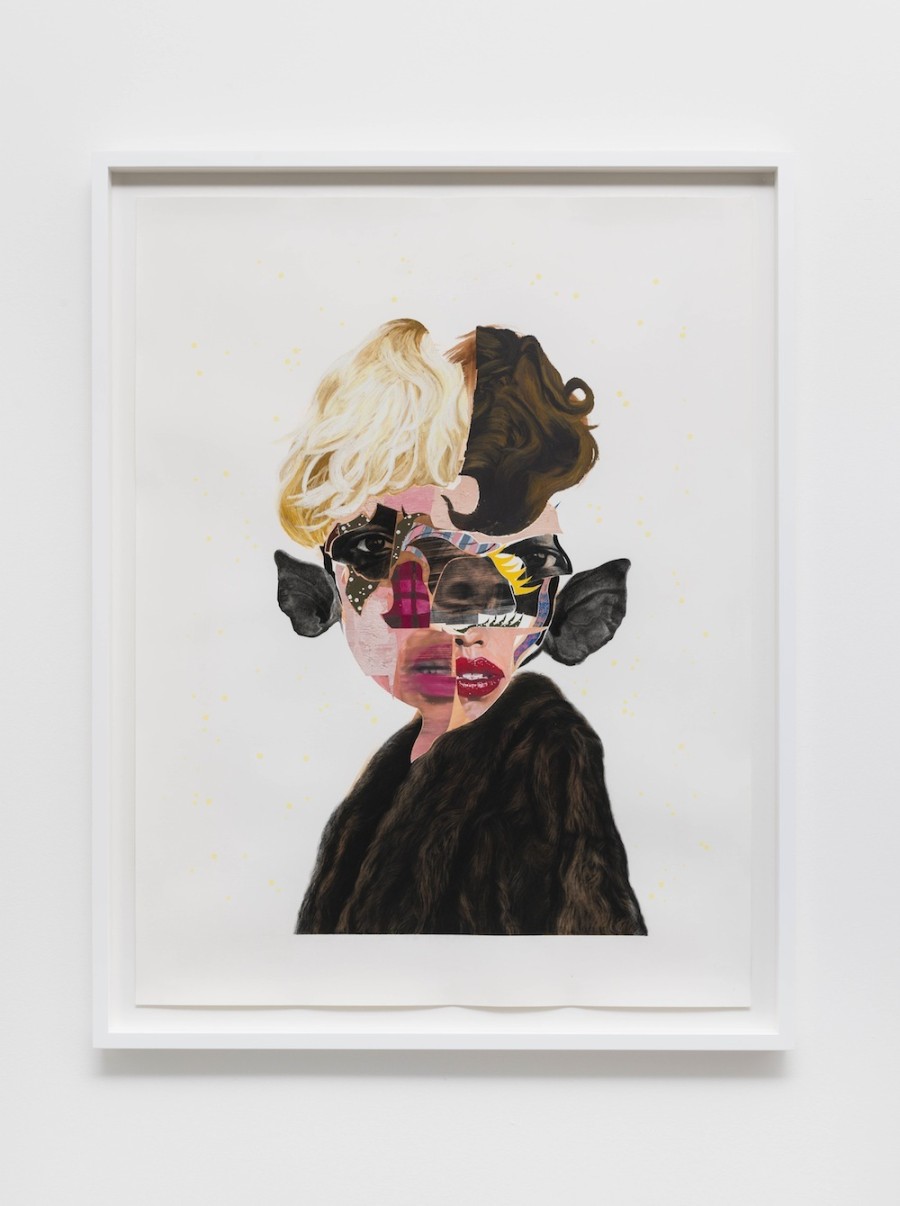
Pig, 2014, black charcoal, oil-pastel, oil-paint, paint-stick, gouache on Lenox Paper
Where do you find inspiration outside of the art world?
I find inspiration in music and film. In particular, I watch many Youtube videos of hip-hop producers working in the studio as they make beats for new rap songs. I especially enjoy this one video clip of Kanye West working in the studio. He seems incredibly free, working in the moment, feeling the energy of the music that he is creating, being completely liberated by the sound and the bass. This also seems to be true of various musicians, such as D’Angelo, Stevie Wonder, and Raphael Saadiq. When you listen to their music, you sense the existence of effortless energy, where excessive thought is not, or was not, a part of the equation.
And I have an obsession with watching films where the protagonist is seemingly outgunned, or intellectually challenged, or diminutive in a certain fashion. Films that come to mind are “Forrest Gump” and “Shawshank Redemption,” for example. My parents were illiterate. As a result, along with other reasons, I have struggled, throughout my life, with feelings of inferiority as they relate to my level of academic intelligence, and I know what it feels like to so eagerly want to escape a place that did not seem rightfully suited for you, a place in which you felt trapped with no means of escape. However, like in the films, redemption, somehow, is achieved, and hard work has a great deal to do with it.
If you could compare your artistic process to another activity -- making spaghetti, performing surgery, riding a bicycle -- what would you say and why?
I always say that my studio art practice is equivalent to surgery because there are so many intricate and highly important processes necessary for making one of my pieces. I spend long, arduous hours to perform at optimal levels in order to achieve a perfection that is suitable for me, and, like any surgeon, mediocrity is not an option. And I have an obsessive compulsion for order and organization. I am addicted to processes being clean and sharp, absent of mishaps and mistakes. For the body of work at Pace London, I arrived to a point where I worked every single day, Monday through Sunday, from 10 a.m. to 4 a.m. –- for three and a half months, non-stop.
Quinn's "Past/Present" runs from September 5 until October 4, 2014 at Pace Gallery in London. See more work from the exhibition below.

